
Odysseus, also known by the Latin variant Ulysses, is a legendary Greek king of Ithaca and the hero of Homer's epic poem the Odyssey. Odysseus also plays a key role in Homer's Iliad and other works in that same epic cycle.

Mycenae is an archaeological site near Mykines in Argolis, north-eastern Peloponnese, Greece. It is located about 120 kilometres south-west of Athens; 11 kilometres north of Argos; and 48 kilometres south of Corinth. The site is 19 kilometres inland from the Saronic Gulf and built upon a hill rising 900 feet above sea level.
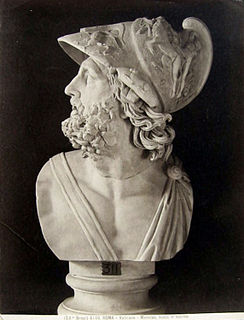
In Greek mythology, Menelaus was a king of Mycenaean (pre-Dorian) Sparta. According to the Iliad, Menelaus was a central figure in the Trojan War, leading the Spartan contingent of the Greek army, under his elder brother Agamemnon, king of Mycenae. Prominent in both the Iliad and Odyssey, Menelaus was also popular in Greek vase painting and Greek tragedy, the latter more as a hero of the Trojan War than as a member of the doomed House of Atreus.

In Greek mythology, as recorded in Homer's Iliad, Patroclus was a childhood friend, close wartime companion, and the presumed lover of Achilles.
In Greek mythology, Menestheus was a legendary king of Athens during the Trojan War. He was set up as king by the twins Castor and Polydeuces when Theseus travelled to the Underworld after abducting their sister, Helen, and exiled Theseus from the city after his return.

Mycenaean Greece was the last phase of the Bronze Age in Ancient Greece, spanning the period from approximately 1750 to 1050 BC. It represents the first advanced and distinctively Greek civilization in mainland Greece with its palatial states, urban organization, works of art, and writing system. The Mycenaeans were autochthonous Greeks who were likely stimulated by their contact with Minoan Crete and other Mediterranean cultures to develop a more sophisticated sociopolitical culture of their own. The most prominent site was Mycenae, after which the culture of this era is named. Other centers of power that emerged included Pylos, Tiryns, Midea in the Peloponnese, Orchomenos, Thebes, Athens in Central Greece and Iolcos in Thessaly. Mycenaean and Mycenaean-influenced settlements also appeared in Epirus, Macedonia, on islands in the Aegean Sea, on the south-west coast of Asia Minor, the Levant, Cyprus, and Italy.

Nestor of Gerenia was the legendary wise King of Pylos described in Homer's Odyssey. Excavations from 1939 revealed his palace, and excavations have recently resumed at the site.

The Mask of Agamemnon is a gold funeral mask discovered at the ancient Greek site of Mycenae. The mask, displayed in the National Archaeological Museum of Athens, has been described by Cathy Gere as the "Mona Lisa of prehistory".

The extent of the historical basis of the Homeric epics has been a topic of scholarly debate for centuries. While researchers of the 18th century had largely rejected the story of the Trojan War as fable, the discoveries made by Heinrich Schliemann at Hisarlik reopened the question in modern terms, and the subsequent excavation of Troy VIIa and the discovery of the toponym "Wilusa" in Hittite correspondence has made it plausible that the Trojan War cycle was at least remotely based on a historical conflict of the 12th century BC, even if the poems of Homer are removed from the event by more than four centuries of oral tradition.
The Ballet Azul is a term coined in Colombia in the 1950s to describe the Millonarios football team, during its successful period from 1949–1964, because the blue color of their uniform, the large number of titles who had won the team, and the quality of its game. The term was first used by the sportscaster Carlos Arturo Rueda.
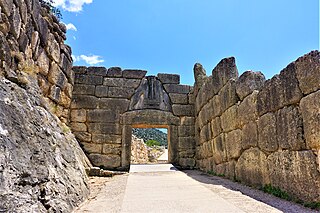
Lion Gate is the popular modern name for the main entrance of what was the Bronze Age citadel of Mycenae in southern Greece. It was erected during the thirteenth century BC, around 1250 BC, in the northwestern side of the acropolis. In modern times, it was named after the relief sculpture of two lionesses in a heraldic pose that stands above the entrance.

The Iliad is an ancient Greek epic poem in dactylic hexameter, traditionally attributed to Homer. Usually considered to have been written down circa the 8th century BC, the Iliad is among the oldest extant works of Western literature, along with the Odyssey, another epic poem attributed to Homer, which tells of Odysseus's experiences after the events of the Iliad. In the modern vulgate, the Iliad contains 15,693 lines, divided into 24 books; it is written in Homeric Greek, a literary amalgam of Ionic Greek and other dialects. It is usually grouped in the Epic Cycle.

Helmets using ivory from boars' tusks were known in the Mycenaean world from the 17th century BC to the 10th century BC. The helmet was made through the use of slivers of boar tusks which were attached to a leather base, padded with felt, in rows. A description of a boar's tusk helmet appears in book ten of Homer's Iliad, as Odysseus is armed for a night raid to be conducted against the Trojans.
Meriones gave Odysseus a bow, a quiver and a sword, and put a cleverly made leather helmet on his head. On the inside there was a strong lining on interwoven straps, onto which a felt cap had been sewn in. The outside was cleverly adorned all around with rows of white tusks from a shiny-toothed boar, the tusks running in alternate directions in each row.
Μηριόνης δ' Ὀδυσῆϊ δίδου βιὸν ἠδὲ φαρέτρην
καὶ ξίφος, ἀμφὶ δέ οἱ κυνέην κεφαλῆφιν ἔθηκε
ῥινοῦ ποιητήν: πολέσιν δ' ἔντοσθεν ἱμᾶσιν
ἐντέτατο στερεῶς: ἔκτοσθε δὲ λευκοὶ ὀδόντες
ἀργιόδοντος ὑὸς θαμέες ἔχον ἔνθα καὶ ἔνθα
εὖ καὶ ἐπισταμένως: μέσσῃ δ' ἐνὶ πῖλος ἀρήρει.
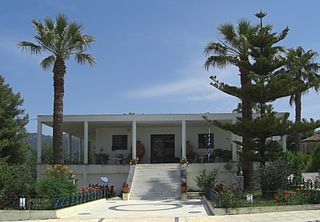
The Archaeological Museum of Chora is a museum in Chora, Messenia, in southern Greece, whose collections focus on the Mycenaean civilization, particularly from the excavations at the Palace of Nestor and other regions of Messenia. The museum was founded in 1969 by the Greek Archaeological Service under the auspices of the Ephorate of Antiquities of Olympia. At the time, the latter included in its jurisdiction the larger part of Messenia.
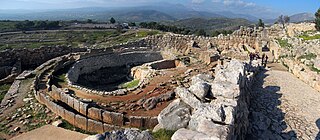
There have been many discoveries of gold grave goods at Grave Circles A and B in the Bronze Age city of Mycenae. Gold has always been used to show status amongst the deceased when used in grave goods. While there's evidence that the practice of grave goods and monumentalizing graves to show status was used throughout Ancient Greece from the Bronze Age and passed through the Classical Period, the goods themselves changed over time. However, using gold as a material was a constant status marker. At the Grave Circles in Mycenae, there were several grave goods found that were made out of gold; masks, cups, swords, jewelry, and more. Because there were so many gold grave goods found at this site there's a legend of Golden Mycenae. Each family group would add ostentatious grave goods to compete with the other family groups for who is the wealthiest. There was more gold found at Grave Circle A and B than in all of Crete before the late Bronze Age.

The Pylos Combat Agate is a Minoan sealstone of the Mycenaean era, likely manufactured in Late Minoan Crete. It depicts two warriors engaged in hand-to-hand combat, with a third warrior lying on the ground. It was discovered in the Griffin Warrior Tomb near the Palace of Nestor in Pylos and is dated to about 1450 BCE. The seal has come to be known as Pylos Combat Agate.

The death masks of Mycenae are a series of golden funerary masks found on buried bodies within a burial site titled Grave Circle A, located within the ancient Greek city of Mycenae. There are seven discovered masks in total, found with the burials of six adult males and one male child. There were no women who had masks. They were discovered by Heinrich Schliemann during his 1876 excavation of Mycenae.

Nestor's cup is an eighth century BC wine cup discovered in 1954 in Lacco Ameno on Ischia, the ancient Pithekoussai, an island in the Gulf of Naples (Italy). The cup has a three-line inscription, one of the earliest surviving examples of writing in the Greek alphabet.
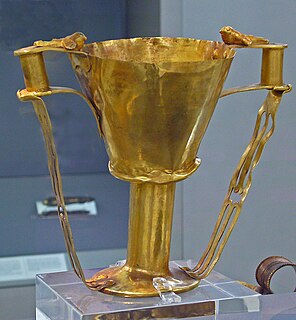
The Cup of Nestor or dove cup is a gold goblet discovered in 1876 by Heinrich Schliemann in Shaft IV of Grave Circle A, Mycenae. The goblet is 14.5 cm high and 14.5 cm across; it weighs 295.8 grams. It has a stem, a Vapheio cup–shaped body, and two handles in the style of a kantharos. Each handle is decorated with a golden bird, which Schliemann observed was reminiscent of the cup of Nestor described in the Iliad. The birds have since been identified by Spiros Marinatos as falcons, rather than the doves which are on the Iliadic cup. J.T. Hooker suggests that the cup is an adaptation of a Cretan design made by a craftsman on the Greek mainland.

In Greek mythology Nestor's Cup is a legendary golden mixing cup which was owned by the hero Nestor. The cup is described in the Iliad, and possibly appeared elsewhere in the Epic Cycle. Despite its brief appearance in the Iliad, the cup was the subject of significant attention from ancient commentators on Homer.

















